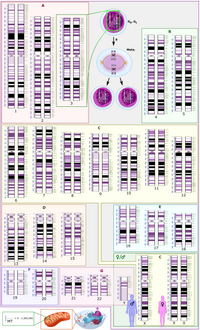
Photo from wikipedia
Aim Recent advances in sequencing, sample and library preparation technologies made it possible to sequence entire genes, haplotypes and genome in human. In this study, we used four approaches; amplicon… Click to show full abstract
Aim Recent advances in sequencing, sample and library preparation technologies made it possible to sequence entire genes, haplotypes and genome in human. In this study, we used four approaches; amplicon based whole gene sequencing, capture probe based MHC haplotype sequencing, PacBio Sequel system based whole genome sequencing and whole genome mapping based on Bionanogenomics’ Technology to study one individual’s MHC. We wanted to compare the information that we have obtained from each technology and confirm the haplotype predictions. Methods We performed whole gene HLA Class I gene sequencing as described earlier (Cereb et al., Hum Immunol. 2015 Dec;76(12):963–74). We performed MHC region target sequence capture using Roche-NimbleGen SeqCap EZ Library. Whole genome sequencing We prepared 40 to 50 kb libraries with 15 to 20 kb cut off size selection and followed manufacturer’s protocol thereafter. Sequencing performed on PacBio Sequel® platform using v2 chemistry and v4 software. Movie time for these large fragments were set to 600 min and secondary analysis is done with SMRTLink’s (v4.0.0) SMRT Analysis Application: de novo Assembly (HGAP 4). To get 85× coverage, we have sequenced the same library in 62 different SMRT® Cell 1 M v2. Whole genome de novo assembly of PacBio sequencing is being performed by DNANexus. BioNano genome mapping was performed by Bio Nano genomics. Results Haplotype determination of the individual tested with whole gene amplicon sequencing performed based on the family studies and is being compared to haplotypes determined by other methods. Conclusions Now thanks to novel technologies we can decipher the complex genetic structure of MHC and other immune response genes with higher precision. This in turn will increase our ability to understand the genetic basis of the complex diseases.
Journal Title: Human Immunology
Year Published: 2017
Link to full text (if available)
Share on Social Media: Sign Up to like & get
recommendations!